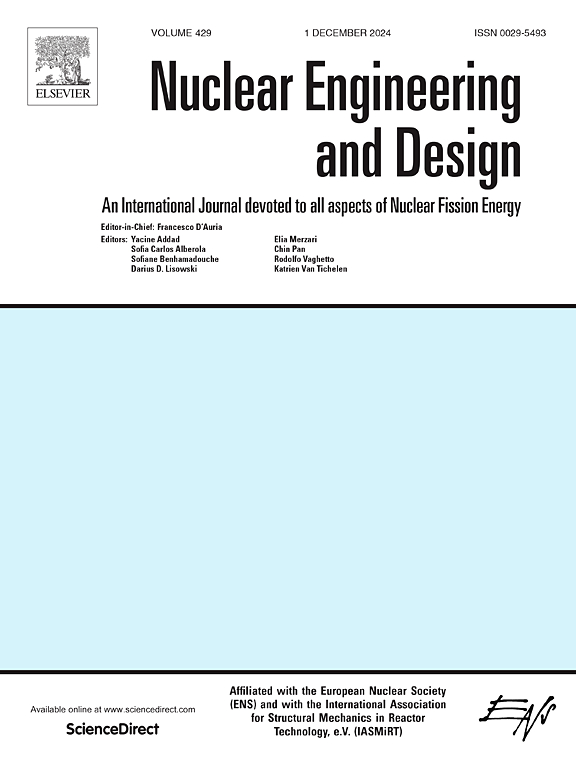基于预测梯度和残差FCN的3DVar数据同化在核电厂主蒸汽系统参数反演优化中的应用
IF 2.1
3区 工程技术
Q1 NUCLEAR SCIENCE & TECHNOLOGY
引用次数: 0
摘要
主蒸汽系统对核电站的安全运行至关重要,预测主蒸汽系统的运行参数是监测主蒸汽系统性能和提高主蒸汽系统能效的重要手段。由于蒸汽管道中的阻尼系数不能直接测量,所以通常采用数值模拟的方法。然而,由于模型的简化和建模参数的不确定性,导致模拟结果与实际存在差异。为了解决这一问题,我们提出了一种新的数据同化方法ResFCN-3DVar,该方法利用可观测量来优化建模参数。该方法的主要创新在于利用基于残差的全连接网络(ResFCN)构造观测算子,有效地处理了非线性复杂的系统级模型。此外,我们在3DVar框架中加入了二阶有限差分矩阵以提高计算效率。在全范围模拟器模拟的数据集上进行的实验表明,同化结果的均方根误差(RMSE)保持在1%以下,证明了ResFCN-3DVar在优化建模参数方面的有效性。本文章由计算机程序翻译,如有差异,请以英文原文为准。
3DVar data assimilation for inversion optimization of main steam system parameters in nuclear power plants using forecast-gradient and residual FCN
The main steam system is crucial for the safety of nuclear power plants, and predicting its operating parameters is essential for monitoring system performance and improving energy efficiency. Since the damping coefficients in steam pipes cannot be directly measured, numerical simulations are typically used. However, model simplifications and uncertainties in modeling parameters lead to discrepancies between the simulations and actual. To address this issue, we propose ResFCN-3DVar, a novel data assimilation method that optimizes modeling parameters using observable quantities. The primary innovation lies in leveraging a residual-based fully connected network (ResFCN) to construct the observation operator, effectively handling the nonlinear and complex system-level model. Additionally, we incorporate a second-order finite difference matrix within the 3DVar framework to improve computational efficiency. Experiments using a dataset simulated by the full-scope simulator showed that the root-mean-square error (RMSE) of the assimilation results remained below 1%, demonstrating the effectiveness of ResFCN-3DVar in optimizing modeling parameters.
求助全文
通过发布文献求助,成功后即可免费获取论文全文。
去求助
来源期刊

Nuclear Engineering and Design
工程技术-核科学技术
CiteScore
3.40
自引率
11.80%
发文量
377
审稿时长
5 months
期刊介绍:
Nuclear Engineering and Design covers the wide range of disciplines involved in the engineering, design, safety and construction of nuclear fission reactors. The Editors welcome papers both on applied and innovative aspects and developments in nuclear science and technology.
Fundamentals of Reactor Design include:
• Thermal-Hydraulics and Core Physics
• Safety Analysis, Risk Assessment (PSA)
• Structural and Mechanical Engineering
• Materials Science
• Fuel Behavior and Design
• Structural Plant Design
• Engineering of Reactor Components
• Experiments
Aspects beyond fundamentals of Reactor Design covered:
• Accident Mitigation Measures
• Reactor Control Systems
• Licensing Issues
• Safeguard Engineering
• Economy of Plants
• Reprocessing / Waste Disposal
• Applications of Nuclear Energy
• Maintenance
• Decommissioning
Papers on new reactor ideas and developments (Generation IV reactors) such as inherently safe modular HTRs, High Performance LWRs/HWRs and LMFBs/GFR will be considered; Actinide Burners, Accelerator Driven Systems, Energy Amplifiers and other special designs of power and research reactors and their applications are also encouraged.
 求助内容:
求助内容: 应助结果提醒方式:
应助结果提醒方式:


